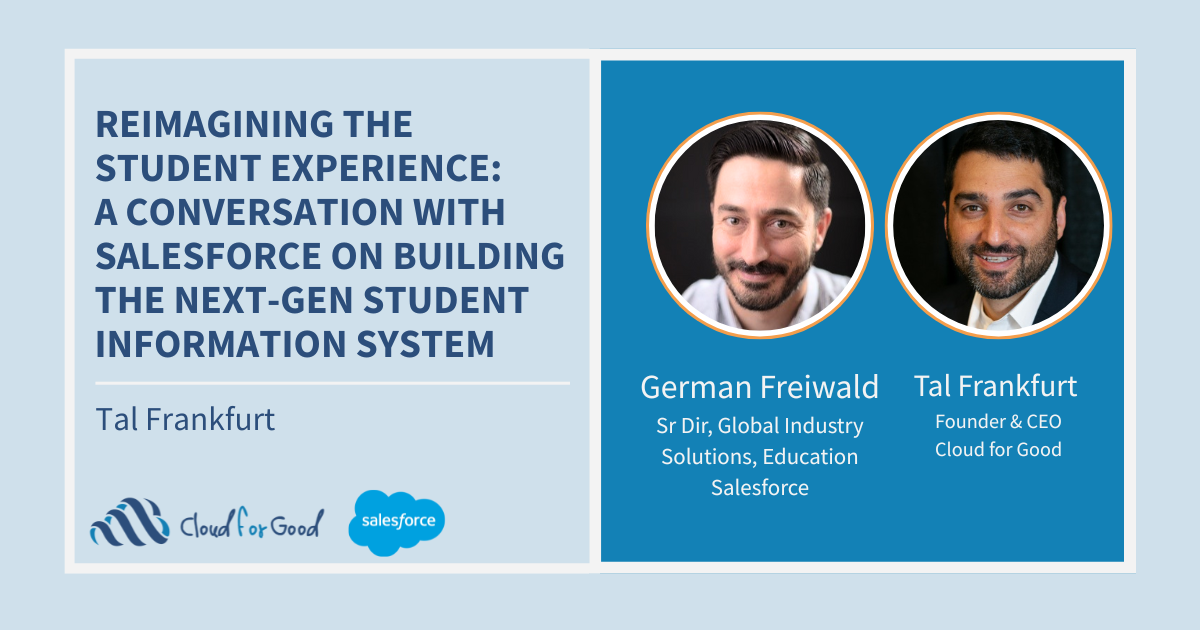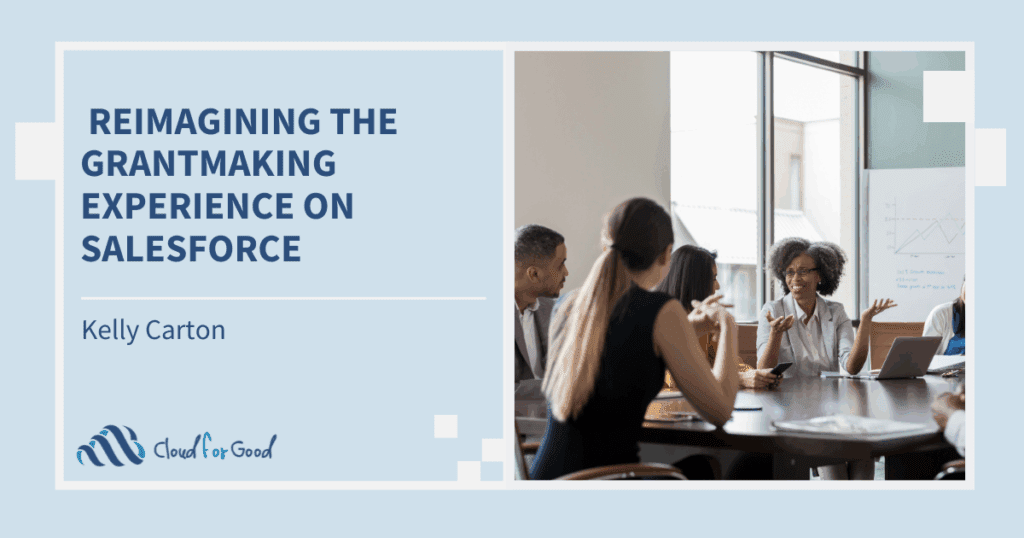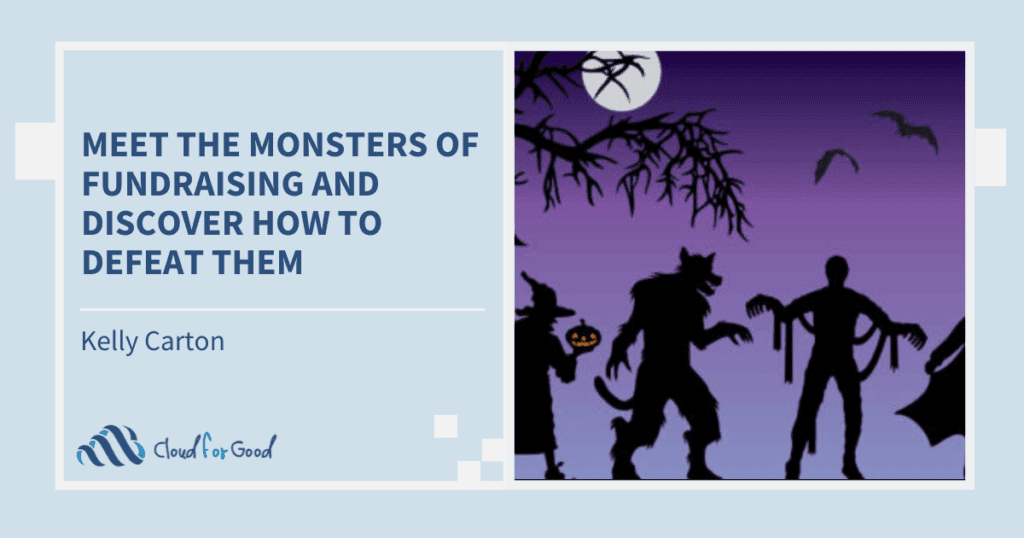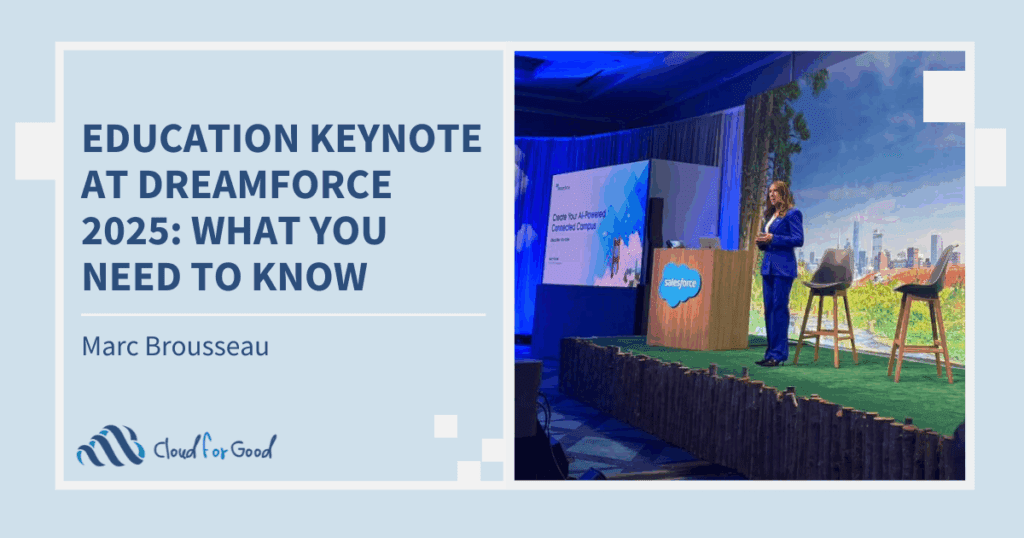Student information systems (SIS) are the backbone of institutional operations. As the demands on higher education grow more complex, the need for modern, connected, and intelligent systems has never been greater.
In my previous article, I shared Cloud for Good’s excitement about Salesforce’s investment building student information system functionality. At Cloud for Good, we’re always watching how technology is evolving in the education and nonprofit spaces — and Salesforce’s approach to rethinking the SIS caught our attention.
To dig deeper, I sat down with German Freiwald, Salesforce’s Education Industry Solutions Senior Director and a driving force behind developing these next-generation SIS capabilities within Education Cloud. We discussed what’s fueling this shift, how AI is changing the game, and why unifying (not just consolidating) systems may be the key to unlocking better student and institutional outcomes.
A Conversation on the Future of Student Information Systems
What Sparked Salesforce's Move into SIS?
Tal Frankfurt (TF): One thing I’ve always admired about Salesforce is how you manage to stay right at the edge of what’s next. Having worked closely with your team for over 15 years, I’ve seen how seriously you take customer feedback. You use it as fuel for innovation. So, what sparked this decision to tackle the SIS space head-on?
German Freiwald (GF): For the past few years, we have heard loud and clear that institutions have mission-critical processes being run on student information systems that predate the demands of students and staff today. Most institutions are using an SIS that is over ten years old, and many still rely on on-premise systems. We consistently hear their frustrations with slow innovation and the challenges of data silos. They are dealing with inflexible infrastructure, leading to time-consuming manual processes and numerous custom-coded workarounds that are difficult and expensive to maintain. Most importantly, we hear about the resulting disconnected student experience that institutions are struggling to modernize, and we see a significant opportunity to help. By building SIS capabilities into Education Cloud over time, we can provide a more modular and manageable path towards embracing a next-gen SIS.
June Release Features
TF: That’s a bold direction – and honestly, an exciting one. We got a taste of what’s coming at Education Summit, but I’d love to hear straight from you: what should institutions be paying attention to in the June release?
GF: In the June release, we’re excited to introduce our initial course registration features for students. We will also introduce functionality for staff to manage student holds and blocks. Perhaps most significant for the long-term development of our next-generation SIS capabilities, we will release an extensible rules engine. This will allow institutions to design and implement auditable academic policies at scale without needing to write code.
AI and Agentforce Integration
TF: That ability to do more with less is something we often hear from our clients, too. Institutions are looking for ways to work smarter, not harder, and AI keeps coming up as a game-changer. Since Salesforce has been weaving AI into your products quickly, how is that shaping the SIS experience you’re building?
GF: Because we are building our next-generation SIS with Agentforce (Salesforce’s agentic AI layer) integrated into our platform, we are considering AI from the very beginning. In fact, we are already planning for Agentforce to assist students with the course registration process in our October release. This new Course Registration Agent, which will help students with personalized course recommendations, is just one example of how we aim to modernize the student experience.
Addressing Current SIS Challenges
TF: I love the idea of turning course registration into a guided, intelligent experience. Not only is it more helpful for students, but it lets staff spend more time supporting students instead of getting buried in admin work – a huge challenge for many institutions. From your perspective, what other challenges is this new SIS trying to solve?
GF: A major problem we see creating several downstream challenges in education is disconnected and trapped data. Consequently, the education technology market is full of vendors who claim to “do it all” by offering SIS, HR, and finance solutions from a single source. This might seem like an appealing way to avoid data silos – with the idea being, “if we can’t integrate the tools we like best, maybe it’s better to just choose one platform with all the tools we need.” However, this doesn’t truly solve the underlying problem.
Single Vendor vs. Multi-Vendor Approach
TF: Okay, let me play devil’s advocate for a second. If disconnected data is such a big issue, wouldn’t choosing a single vendor for everything solve that problem?
GF: Well, having worked with thousands of educational institutions for over a decade, we have yet to find one that gets everything they need from a single vendor. While it sounds great in theory, it rarely materializes in practice. Many institutions have one vendor for their SIS, finance, and HR, but their LMS is from a different vendor, recruiting and admissions another, career services another, advising another, course schedules another, and so on. Soon, we anticipate that multiple large language models (LLMs) and AI agents will also be commonplace. Despite significant efforts at technology consolidation, fragmentation inevitably occurs, and we don’t see great solutions for dealing with this reality in the SIS market today.
Differentiation in the Market
TF: So, if the “one vendor to rule them all” approach doesn’t cut it, what makes your solution stand apart in such a noisy, complex market?
GF: We are excited to flip the traditional, closed, monolithic ERP platform concept on its head and bring our deeply unified platform approach to the SIS space. Our approach is built on Salesforce’s modular, open-platform ecosystem that puts students and staff at the center. We understand that institutions will have multiple vendors. For this reason, the foundation of our next-generation SIS capabilities is Data Cloud. Data Cloud is our hyperscale data platform designed to unify and harmonize disparate data using modern, zero-copy data integration techniques. More importantly, this data can be virtualized within Education Cloud, allowing staff or AI agents via Agentforce to then take action on this harmonized data.
Role of Consolidation
TF: It sounds like you’re not anti-consolidation but rather pro-strategy. What role do you see consolidation playing in your broader approach?
GF: Of course, we recognize the many benefits of technology consolidation. For example, we’ve seen how Walsh College experienced tremendous efficiency gains by moving from disparate point solutions for recruiting and admissions, advising, and advancement to using our Education Cloud platform for all three. Consolidation is a powerful tactic, and we are excited to help institutions leverage the full power of the Education Cloud platform to streamline and modernize their processes. That said, we also know that consolidation alone is not a comprehensive strategy to address the challenge of data silos. Institutions will always have multiple vendors, and designing for that reality requires going beyond the traditional tactic of tech consolidation.
SIS for a Multi-Vendor Environment
TF: We’ve also seen the value of unification at Cloud for Good, but many institutions are taking a more phased approach. Louisiana State University, for example, unified their recruitment data across their online and continuing education programs. This ability to see all data in one location has led to them reaching 105% of their recruitment goals and 116% of admission goals. But, as you said, most institutions still need to work with multiple vendors. What does an SIS look like when it’s truly designed for that environment?
GF: Our deeply unified platform approach to a next-gen SIS is a ‘yes and’ approach: YES, we can help you consolidate disparate point solutions onto Education Cloud, AND we will also use Data Cloud to help you thrive in a multi-vendor world by unifying and harmonizing all your data and allowing you to virtualize it in Education Cloud. The ‘and’ is critical here. We see that as a major gap in the market today. Once you have harmonized all your data and can virtualize it in Education Cloud, your staff and/or your Agentforce (our agentic AI layer) can securely take action on this data. This is at the heart of our deeply unified platform approach to a next-gen SIS, it is an SIS for continuous improvement.
Taking Action on Data
TF: You mentioned Agentforce and the ability to actually take action on harmonized data – which is the dream, right? But let’s make it tangible: what does “taking action” look like for institutions today? Or, say, a year down the road?
GF: Taking action translates into taking practical steps like creating a case, raising an alert, instituting a hold, or sending a personalized message. Importantly, these can be automated within Education Cloud through simple, maintainable no-code flows. The true potential lies in using all your data – not limited to your SIS or ERP – alongside predictive and agentic AI to determine and take the optimal next actions for learners. This isn’t a silver bullet; it’s about harnessing the full power of your technology to achieve continuous, data-driven improvement in educational and operational outcomes, which is why many of us got into education technology in the first place!
Reimagining the Student Experience with a Next-Gen SIS
As our conversation ended, one thing was undeniable: Salesforce isn’t just creating another SIS. They’re reimagining what an SIS can be. Their vision reflects the complexity of today’s educational landscape while embracing tomorrow’s opportunities. Personalization, agility, and actionable insights are no longer optional, and Salesforce’s deeply unified, modular approach offers institutions a path toward modernization and meaningful transformation. This next-gen SIS isn’t simply about replacing outdated systems. It’s about unlocking new possibilities, empowering students and staff, and building a foundation for continuous innovation.





